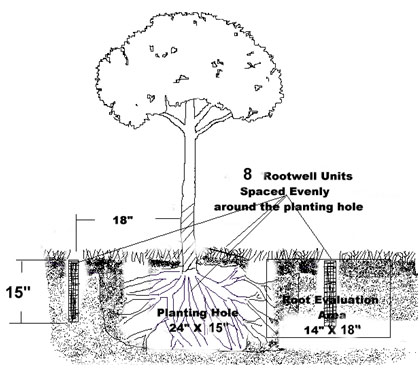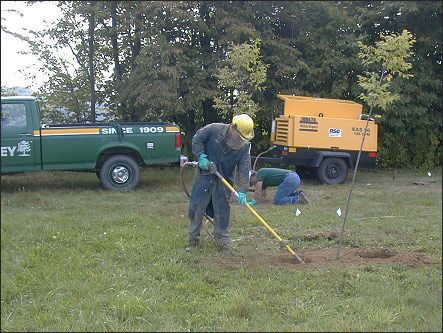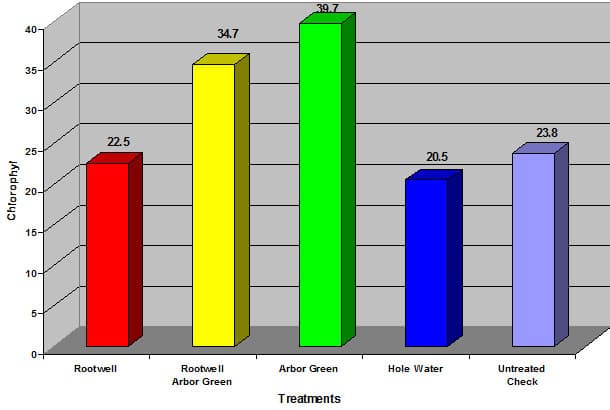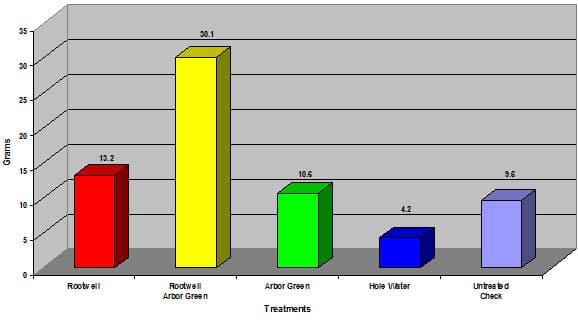Scientific Data: Evidence Rootwell Prevents Surface Roots
Evaluation of Rootwell® System in the Establishment and Health of Bare Root Transplanted Trees
Proper establishment and recovery of trees in the urban landscape is a major problem. Proper planting and post-planting care such as watering, mulching, and deep root fertilizing may not always provide trees with an environment that is favorable for root development. Often soil compaction outside of the planting hole and stresses caused by turfgrass and other landscape plants competing for soil, water, oxygen, and nutrients may limit tree root development. Installing the Rootwell system outside of the planting hole, when bare root trees are planted, may assist in providing plants a more favorable environment, by providing water/fertilizer penetration and oxygen transfer. The Rootwell system may also provide an environment for tree roots to grow deeper, which would permit them to withstand droughts. This long-term study was initiated in 1999 with the cooperation of Rootwell Company.
In recent years there has been an increased concern regarding tree and shrub fertilization. There are reports/speculations that fertilization performed for plant health management can increase pest problems, and can leach into the soil and contaminate ground water. There are also speculations that fertilization can increase top growth without increasing root growth. However, other scientists have reported that proper fertilization practices can help improve plant health. In this trial, we were interested in finding answers to these questions.
Objective
To determine the benefit of the Rootwell System and fertilizer in the establishment of newly transplanted trees.
Materials and Methods
This study was conducted in silt-loam soil, in Freedom, Ohio, at the Davey Tree Research Station. Each of the five treatments (Table 1) had three, one-inch diameter, bare root, white ash (Fraxinus americana) trees planted in a hole approximately 24 inches in diameter by 12-15 inches deep on 06/04/99.
We greatly appreciate the cooperation and assistance provided by Rootwell Co. representatives, Sarah Arrington and Joe Webber for technical assistance.
Treatments were applied on June 9,1999 (Table 1). For the fertilizer treatments, Davey Arbor Green® 30-10-7 fertilizer was applied at 6 lbs. N per 1,000 square feet. The fertilizer was applied using a subsurface deep-root fertilization method, which applies 1 gallon of material per injection point. Eight injection holes were placed outside of the planting hole on 18-inch centers (Figure 1). Four holes were placed at the cardinal points (N, E, S, and W), 18-inches from the trunk of the trees, and four holes were placed in between the cardinal points (NW, NE, SW, and SE). For the treatments that required fertilization and the Rootwell System, the trees were fertilized first using a 15-inch long probe with a 5/8-inch diameter. Once the 5/8-inch fertilization probe inserted 15 inches deep is removed from the injection site, a 5/8-inch X 15-inch long Rootwell was installed in the same hole. In the Rootwell System treatments and the water alone treatments, the fertilizer probe applying one gallon of water was also used to make eight holes every 45 degrees around the trunk of the trees. Each treatment was replicated three times in a randomized complete block design.
Figure 1

Table 1.
|
Treatments |
Number of Trees |
|
8, 5/8” Rootwell units1 |
3 |
|
Arbor Green 6 lbs. N per 1,000 sq. ft. + 8, 5/8” Rootwell units1 |
3 |
|
Arbor Green 6 lbs./N 1,000 sq. ft. 1 |
3 |
|
8, 5/8” hole1 |
3 |
|
Untreated Check |
3 |
1A 5/8” fertilizer probe 15” long was used to apply one gallon of water or fertilizer mixture per hole. The holes were evenly spaced every 45 degrees around the trunk of the trees.
Above ground treatment response was evaluated at the 14 months after treatment, by recording the twig growth, height, trunk caliper (diameter), color (SPAD chlorophyll meter), and appearance rating (where 1=poor; 10=good).
Below ground response was evaluated15 months after planting by sampling two areas 14 inches in diameter and 18 inches deep from each tree, centered around the treated area on the north and south sides of the tree, and recording root biomass (Figure 2).
The data were analyzed using analysis of variance (ANOVA). Means (averages) were separated using Duncan’s NMRT @ P+0.05. Daily precipitation and temperature data are also included in the appendix.
Figure 2

August 28, 2000. Root evaluation using an air spade to excavate the evaluation area.
Results and Discussion
There were no significant differences among any of the treatments when above ground growth responses (twig growth, height, diameter) or appearance ratings were evaluated 14 months after treatment (Table 2). When color was evaluated during the final evaluation period using a SPAD chlorophyll meter the two treatments containing fertilizer were significantly greener than all of the other non-fertilized treatments (Figure 2, Table 3).
Below ground response was evaluated15 months after planting by sampling two areas, 14 inches in diameter and 18 inches deep from each tree, centered around the treated area on the north and south sides of the tree, and recording root biomass.
The treatment that received the Rootwell units and Arbor Green had three times more roots in the sampled areas when fresh root weight was evaluated than the untreated check plants, and had significantly more roots than all of the other treatments (Figure 3, Table 4).
In this study, we found a significant increase in root biomass and fresh root weight without an increase in top growth. We have also reported this type of response to fertilizer in previous studies. In addition, there were no pest or abiotic problems observed on any of the treatments over a period of two years.
Contrary to speculations, we found a significantly greater root biomass and fresh root weight in fertilizer treatments than untreated checks without an increase in top growth. In our opinion, proper fertilization and proper improvement of soil aeration can positively improve overall plant health and should be included as a part of the plant health care management tool. Rootwell Systems should be a good tool to use in areas where hardscape, like concrete, exits.
Table 2. Rootwell/Arbor Green Study.
|
Treatment |
1999 Caliper Diameter |
14 MAT Diameter Increase |
1999 Height |
14 MAT Height Increase |
Avg. Twig Length 1999 |
Avg. Twig Length 2000 |
|
Rootwell |
.753 |
.273 |
79.5 |
27.17 |
9.18 |
7.77 |
|
Rootwell Arbor Green |
.707 |
.187 |
82 |
26.67 |
9.38 |
8.47 |
|
Arbor Green |
.713 |
.217 |
83.17 |
24.5 |
8.83 |
11.53 |
|
Hole Water |
.697 |
.32 |
82.83 |
20.5 |
6.77 |
7.2 |
|
Untreated Check |
.687 |
.277 |
81.67 |
22.67 |
7.93 |
9.47 |
|
LSD P = 0.05 |
.0465 |
.1462 |
6.97 |
12.27 |
3.14 |
5.04 |
|
The Data were analyzed using analysis of variance (ANOVA). Means (averages) were separated using Duncan’s NMRT @ 0.05. |
||||||
Conclusion
In this preliminary study, it was found that 5/8” × 15” long Rootwell units and Arbor Green alone, increased foliar color and root biomass. However, the combination of both Arbor Green and Rootwell treatments significantly increased the foliar color and root biomass. Above ground response was not significant. The increase in root biomass and color should help improve overall plant health in the long run. Rootwell units must be improving the nutrient, air and water movement in compacted soil.
Figure 2: Color (SPAD) Reading

Table 3. SPAD Color Reading.
|
Treatments |
Color Spad Reading |
|
Rootwell |
22.5 |
|
Rootwell Arbor Green |
34.7 |
|
Arbor Green |
39.7 |
|
Hole Water |
20.5 |
|
Untreated Check |
23.8 |
|
LSD P= 0.05 |
7.55 |
|
The Data were analyzed using analysis of variance (ANOVA). Means (averages) were separated using Duncan’s NMRT @ 0.05 |
|
Figure 3: Fresh Root Weight in Grams

Table 4. Fresh Root Weight.
|
Treatments |
Fresh Root Weight in Grams |
|
Rootwell |
13.2 |
|
Rootwell Arbor Green |
30.1 |
|
Arbor Green |
10.6 |
|
Hole Water |
4.2 |
|
Untreated Check |
9.6 |
|
LSD P = 0.05 |
13.71 |
|
The Data were analyzed using analysis of variance (ANOVA). Means (averages) were separated using Duncan’s NMRT @ 0.05 |
|
